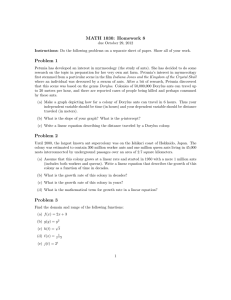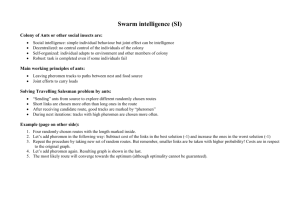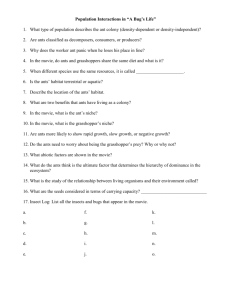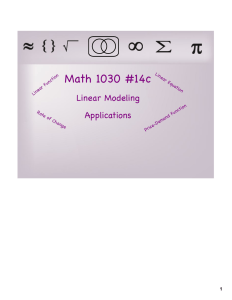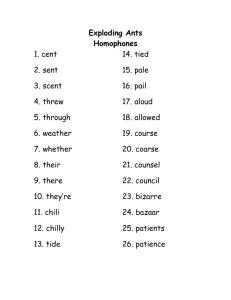MATH 1030: Homework 8
advertisement
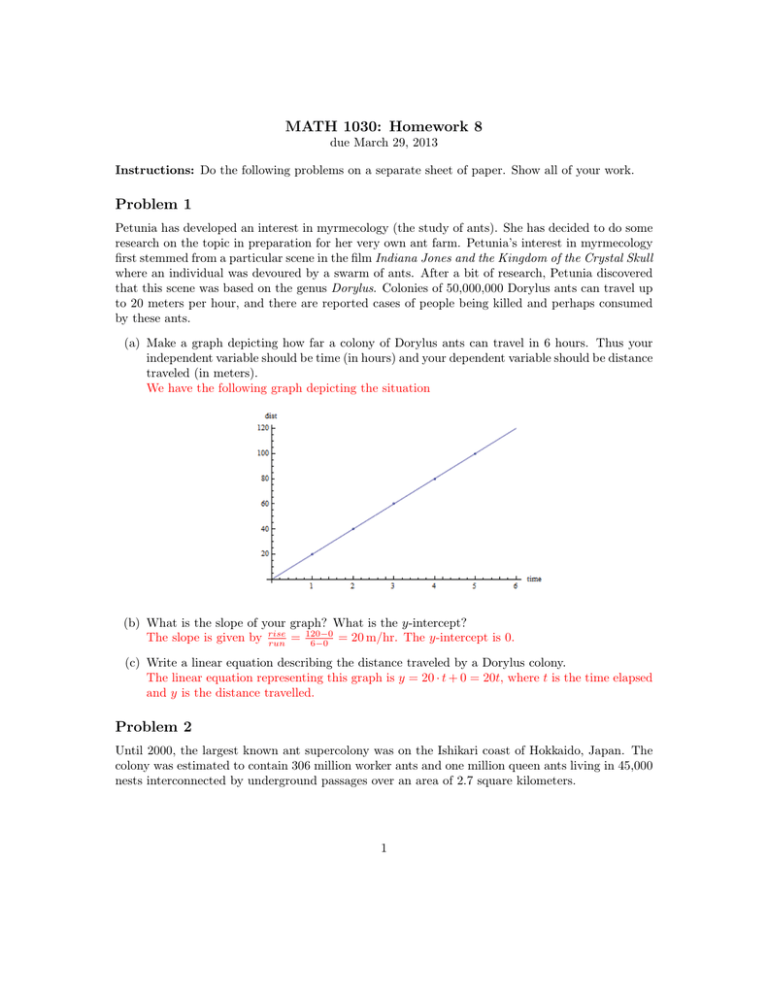
MATH 1030: Homework 8
due March 29, 2013
Instructions: Do the following problems on a separate sheet of paper. Show all of your work.
Problem 1
Petunia has developed an interest in myrmecology (the study of ants). She has decided to do some
research on the topic in preparation for her very own ant farm. Petunia’s interest in myrmecology
first stemmed from a particular scene in the film Indiana Jones and the Kingdom of the Crystal Skull
where an individual was devoured by a swarm of ants. After a bit of research, Petunia discovered
that this scene was based on the genus Dorylus. Colonies of 50,000,000 Dorylus ants can travel up
to 20 meters per hour, and there are reported cases of people being killed and perhaps consumed
by these ants.
(a) Make a graph depicting how far a colony of Dorylus ants can travel in 6 hours. Thus your
independent variable should be time (in hours) and your dependent variable should be distance
traveled (in meters).
We have the following graph depicting the situation
(b) What is the slope of your graph? What is the y-intercept?
120−0
The slope is given by rise
run = 6−0 = 20 m/hr. The y-intercept is 0.
(c) Write a linear equation describing the distance traveled by a Dorylus colony.
The linear equation representing this graph is y = 20 · t + 0 = 20t, where t is the time elapsed
and y is the distance travelled.
Problem 2
Until 2000, the largest known ant supercolony was on the Ishikari coast of Hokkaido, Japan. The
colony was estimated to contain 306 million worker ants and one million queen ants living in 45,000
nests interconnected by underground passages over an area of 2.7 square kilometers.
1
(a) Assume that this colony grows at a linear rate and started in 1950 with a mere 1 million ants
(includes both workers and queens). Write a linear equation that describes the growth of this
colony as a function of time in decades.
∆ dep. var.
= 6, 120, 000 ants per
= 307,000,000−1,000,000
The rate of growth of the colony is
2000−1950
∆ ind. var
year. To make a linear function to model this, we need to find the y-intercept. We can plug
in either point (I am using the first one) to find this:
1, 000, 000 = 6, 120, 000 · 1950 + b
=⇒
b = −11, 933, 000, 000
So the linear equation describing this is y = 6, 120, 000x − 11, 933, 000, 000.
(b) What is the growth rate of this colony in decades?
We already have found the growth rate in years, namely 6, 120, 000 ants per year. Then in
one decade, the colony will grow by 6, 120, 000 × 10 = 61, 200, 000. Note that we could also
view this as a unit conversion problem.
(c) What is the growth rate of this colony in years?
We found this in part (a). The colony grows at a rate of 6, 120, 000 ants per year.
(d) What is the mathematical term for growth rate in a linear equation?
The mathematical term for growth rate is slope.
Problem 3
Find the domain of the following functions:
(a) f (x) = 2x + 3
Since every input to this function makes sense, the domain is all real numbers (or just all
numbers). The only time you have to worry that the domain may not be all numbers is if
you see a variable in the denominator (so that the denominator may be zero) or if you see a
square root (because we can’t take the square root of a negative number).
(b) g(y) = y 2
As per the discussion in (a), the domain is all of R.
√
(c) h(t) = t
Again referring to the discussion in (a), since we cannot take the square root of a negative
number, the domain is {x ∈ R : x ≥ 0} or all positive numbers.
1
(d) `(x) = x−3
All values of x make sense for `(x) except when the denominator is zero, and that happens
only when x − 3 = 0 which implies x = 3. So the domain is all numbers not equal to 3
(e) j(t) = 2t
All values of t make sense for this function, so the domain is all of R.
2
Problem 4
Determine whether the following situations represent linear growth/decay or exponential growth/decay
and then answer the question.
(a) Timmy buys 5 new Pokemon cards per day. If he had 212 cards one week ago, how many
does he have now?
This represents linear growth. Today he has 212 + 5 · 7 = 247 cards.
(b) Carbon-14 has a half-life of 5730 years. That means the the amount of Carbon-14 in an
object is cut in half ever 5730 years. If a skeleton has 80% of its original Carbon-14 now,
what percent will remain 17,190 years from now?
This represents exponential decay. Notice that 17,190
5730 = 3, so in 17.190 years, the amount of
Carbon-14 is cut in half three times successively. After the first 5, 730 years, there is 40% of
the original amount. After the second half-life, there will be half of 40%, or 20% of the original
amount. After the third half-life, there will be 10% of the original amount of Carbon-14 in
the skeleton.
(c) Hang-glider prices are increasing by 4% per month. If hang-gliders cost $2, 200 today, how
much will they cost 4 months from now?
This represents exponential growth. Using the exponential growth formula, four months from
now, a hang-glider will cost
P = $2, 200 · (1 + .04)4 = $2, 573.69
3
